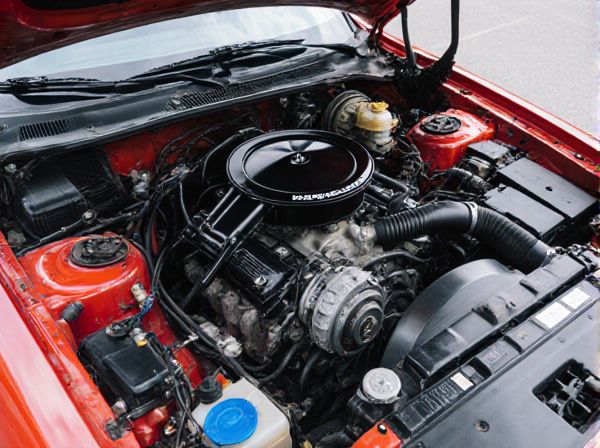
Photo illustration: Cam-in-Block vs Overhead Cam
Cam-in-Block engines have the camshaft located within the engine block, driving the valves via lifters and pushrods, resulting in a more compact design but potentially less precise valve timing. Overhead Cam (OHC) engines place the camshaft above the cylinder head, offering more direct control of the valves, improved efficiency, and higher RPM capabilities. Choosing between the two affects your engine's performance, maintenance complexity, and fuel efficiency, with OHC generally favored for modern, high-performance vehicles.
Table of Comparison
| Feature | Cam-in-Block (Pushrod) | Overhead Cam (OHC) |
|---|---|---|
| Camshaft Location | Engine block | Above cylinder head |
| Valve Operation | Pushrods and rocker arms | Direct actuation, no pushrods |
| Engine Size | Compact vertical height | Higher engine height |
| RPM Capability | Lower maximum RPM | Higher RPM range |
| Power Output | Moderate, due to valve float limits | Higher power due to precise valve timing |
| Complexity | Simple and robust | More complex and costly |
| Maintenance | Easier, fewer moving parts | Requires precise adjustments, more parts |
| Common Usage | Muscle cars, trucks | Modern cars, performance engines |
Introduction to Cam-in-Block and Overhead Cam Designs
Cam-in-block engines feature the camshaft located within the engine block, directly operating the valves via lifters and pushrods, which typically results in a more compact design with fewer moving parts. Overhead cam (OHC) designs position the camshaft above the cylinder head, allowing for more precise valve timing, higher engine speeds, and improved performance. The difference in camshaft placement significantly influences engine complexity, efficiency, and power delivery characteristics.
Historical Evolution of Engine Camshaft Placement
Cam-in-block engines originated in the early 20th century, characterized by their camshaft located within the engine block, driving valves via pushrods and rocker arms. Overhead camshaft (OHC) designs emerged in the mid-1900s, positioning the camshaft above the cylinder head for more precise valve timing and higher engine speeds. The shift from cam-in-block to overhead cam configurations marked a significant evolution in internal combustion engine efficiency and performance.
Fundamental Differences: Cam-in-Block vs Overhead Cam
Cam-in-Block engines feature the camshaft located within the engine block, directly operating the valves via lifters and pushrods, resulting in a compact design but limited high-RPM performance. Overhead Cam (OHC) engines position the camshaft above the cylinder head, allowing more precise valve timing and higher engine speeds due to reduced valve train mass and complexity. The fundamental difference lies in camshaft placement, impacting valve operation efficiency, engine responsiveness, and mechanical complexity.
Advantages of Cam-in-Block (Pushrod) Engines
Cam-in-block (pushrod) engines offer a more compact design, enabling smaller engine dimensions and lighter weight compared to overhead cam (OHC) engines. Their simpler valvetrain architecture results in increased durability and easier maintenance, making them well-suited for rugged applications. Pushrod engines typically provide better low-end torque performance, which enhances acceleration and towing capabilities in vehicles.
Benefits of Overhead Camshaft (OHC) Engines
Overhead Camshaft (OHC) engines offer improved valve timing accuracy and higher engine speeds compared to Cam-in-Block designs, resulting in enhanced performance and fuel efficiency. The direct actuation of valves reduces mechanical complexity and friction, leading to smoother operation and reduced maintenance needs. OHC engines also enable advanced technologies such as variable valve timing and multi-valve configurations, optimizing power output and emissions control.
Performance Comparison: Power, RPM, and Efficiency
Cam-in-Block engines typically deliver robust low-end torque with RPM limits around 6,000 to 7,000, benefiting from simpler valvetrain designs. Overhead Cam (OHC) engines achieve higher power output and can rev between 7,000 and 9,000 RPM or more due to reduced valvetrain inertia and improved airflow control. OHC configurations generally offer better efficiency by enabling more precise valve timing and higher breathing capacity, resulting in superior fuel economy and performance.
Maintenance and Repair Considerations
Cam-in-Block engines typically feature simpler maintenance and lower repair costs due to fewer moving parts and easier access to the camshaft, making valve adjustments straightforward. Overhead Cam (OHC) engines, especially dual overhead cam (DOHC) designs, require more specialized tools and expertise for timing belt or chain replacement, valve clearance adjustments, and camshaft repairs. While OHC engines often deliver better performance, their complex components can lead to higher labor costs and extended service times during maintenance and repair.
Applications: Which Industries Use Each System?
Cam-in-Block engines are commonly used in heavy-duty trucks, agricultural machinery, and industrial equipment where durability and simplicity are critical. Overhead Cam (OHC) engines dominate in passenger cars, motorcycles, and high-performance automotive applications due to better valve timing precision and higher RPM capabilities. The construction and automotive industries favor Cam-in-Block designs for robustness, while OHC systems are preferred in sectors prioritizing fuel efficiency and reduced emissions.
Technological Innovations and Future Trends
Cam-in-block engines feature a simple design with cams located within the engine block, offering durability but limiting valve timing precision compared to overhead cam (OHC) systems. Overhead cam technology places the camshaft above the combustion chamber, enabling higher RPMs, improved fuel efficiency, and reduced emissions through precise valve control. Future trends emphasize variable valve timing, electrification of camshaft components, and integration with hybrid systems to enhance performance and meet stringent environmental regulations.
Choosing the Right Camshaft Design for Your Needs
Choosing between cam-in-block and overhead camshaft designs depends on factors like engine performance, maintenance, and vehicle application. Cam-in-block engines feature a simpler, more compact layout, often providing durability and ease of repair, ideal for basic or heavy-duty uses. Overhead camshaft designs allow for higher RPMs and more precise valve timing, enhancing performance and fuel efficiency, which suits high-performance and modern vehicles.
 caratoz.com
caratoz.com